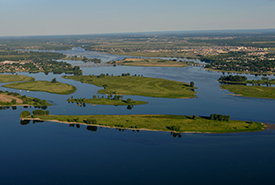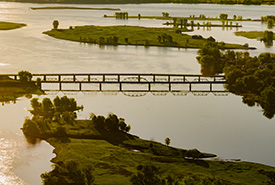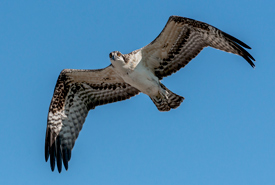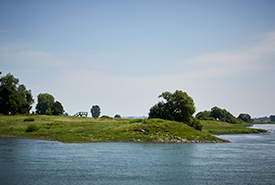Your happy place: Find your own paradise island in the Hochelaga Archipelago

Aerial photo of the Hochelaga Archipelago islands, QC (Photo by ALM Par Avion)
When you think of an island, your mind often travels to a distant oasis, with tall palm trees and saltwater waves crashing onto a white-sand shore. In the midst of the busy-ness of day-to-day life, it’s easy to daydream about a peaceful place where the traffic noises subside and birdsong fills the air.
Whether you live in or near Montreal or are just visiting the city, your new happy place isn’t so far away. Montreal is one of more than 300 islands in the Hochelaga Archipelago. These islands and islets decorate the St. Lawrence and Ottawa rivers. They surround the city, hugging the metropolis with a pearl bracelet of nature, just a short boat ride away. Each island is unique in size and biodiversity, but the largest of the bunch is the city of Montreal itself.
Is canoeing or kayaking your thing? Then grab your paddle because just a few strokes from the east point of Montreal and the riverside towns of Repentigny and Verchères lie the Nature Conservancy of Canada’s (NCC’s) protected islands in the Hochelaga Archipelago.
“[The Archipelago] is a series of really wild islands, not far from downtown Montreal,” says Frederic Hareau. “You could be right in the centre of the city in one moment, but feel very far away from there as soon as you get to the islands.”

Aerial photo of the Hochelaga Archipelago islands at dawn (Photo by Patrice Bériault)
Frederic is a member of Bird Protection Quebec (BPQ), an organization founded in 1917 that works to protect habitat for birds in the province. BPQ works side by side with NCC to protect areas throughout the Hochelaga Archipelago for both people to enjoy and for species to live on.
“These islands are really important areas, especially for birds,” says Frederic. “Particularly as a migratory bird stopover site, there are a number of breeding species here.”
Located where the Prairies and St. Lawrence River meet, the islands boast riparian wetlands and wildflowers. They also offer breathtaking views of the Olympic Stadium and St. Lawrence River. Visitors can immerse themselves in the islands’ unique natural habitats, for an unparalleled experience.
Related blog posts
According to Frederic, around 80 different bird species live on or use these islands as habitat.
Migratory birds are known to frequent this area, making it a hot spot for visitors hoping to catch a glimpse of these birds in action.
“When I went to the islands for the first time, we were out looking for birds,” recalls Frederic. “I turned around and saw a very interesting species — one that’s rare in Quebec — a Say’s phoebe. They come from western North America, and you find them maybe once a year in Quebec.”

Osprey in flight (Photo by Lorne)
In addition to this rare bird, species such as marsh wren and osprey are known to stop on these islands during their long trips in the spring and fall.
“Most of the islands are covered in prairies, grass or wetlands, so you find a number of species that breed in those habitats,” says Frederic. “There’s a lot of diversity here.”
A fine balance
There is a delicate balance between using nature for recreation and respecting it as a home for wildlife. Frederic and BPQ strive to educate Canadians about the importance of maintaining harmony with nature while connecting to it through being outdoors.
NCC encourages visitors to take precautions, such as avoiding areas with high biodiversity activity (nesting birds) when visiting some of the islands, as some of them are very ecologically sensitive. All islands can be observed from the water. Others are accessible to explore on foot, but visitors must be careful not to disturb the aquatic plants in the waters below.
“We want to ensure that areas of the islands are protected as much as possible. But we also know that people enjoy visiting them,” says Frederic. “I think it’s important to educate the public so that people can enjoy nature. There’s a balance between conservation and education.”
While exploring the islands himself, Frederic often speaks with other visitors to offer them a new way to view the land right in front of them — especially on Île aux Canards and Île à l’Aigle, Frederic’s favourite spots to birdwatch.

Observation platform at Île à l'Aigle (Photo by Martin Beaulieu)
“Some people feel like it’s just grass or a field on an island,” he says. “Just by showing them the birds that are around, there’s a richness in that. In 10 minutes, you can help them see that this is a really rich habitat with lots of biodiversity.”
As a father, Frederic sees the value of teaching younger generations about nature and encouraging their curiosity by exploring areas such as the Hochelaga Archipelago.
“In Quebec, we’re really privileged to live in a place surrounded by nature. Unfortunately, in big cities, some people forget their connection with nature. Just going to these islands helps you realize you’re part of an entire ecosystem. It’s an amazing opportunity for discovery and for my children to be in nature.”
Making waves in Quebec
NCC secured the Île aux Moutons property, on the St. Lawrence River, in 1978. It was NCC’s first project in Quebec. Since then, NCC and our partners have worked to protect the natural areas of a growing number of islands and riverbank areas along the St. Lawrence.
To date, NCC has conserved 605 acres (more than 245 hectares) of important habitat in this area.
To learn more about NCC's Nature Destinations across Canada, visit naturedestinations.ca.


